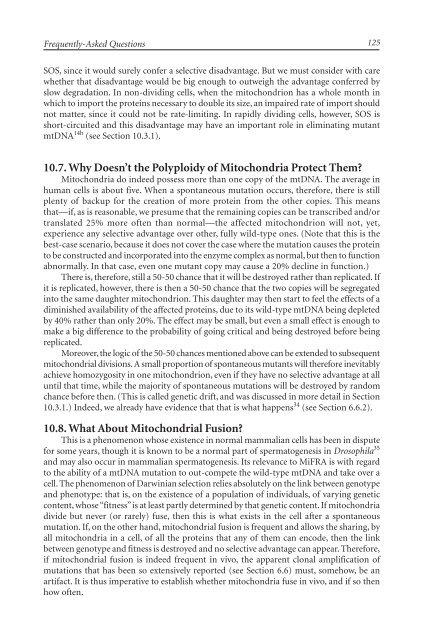The Mitochondrial Free Radical Theory of Aging - Supernova: Pliki
The Mitochondrial Free Radical Theory of Aging - Supernova: Pliki
The Mitochondrial Free Radical Theory of Aging - Supernova: Pliki
You also want an ePaper? Increase the reach of your titles
YUMPU automatically turns print PDFs into web optimized ePapers that Google loves.
Frequently-Asked Questions<br />
SOS, since it would surely confer a selective disadvantage. But we must consider with care<br />
whether that disadvantage would be big enough to outweigh the advantage conferred by<br />
slow degradation. In non-dividing cells, when the mitochondrion has a whole month in<br />
which to import the proteins necessary to double its size, an impaired rate <strong>of</strong> import should<br />
not matter, since it could not be rate-limiting. In rapidly dividing cells, however, SOS is<br />
short-circuited and this disadvantage may have an important role in eliminating mutant<br />
mtDNA 14b (see Section 10.3.1).<br />
10.7. Why Doesn’t the Polyploidy <strong>of</strong> Mitochondria Protect <strong>The</strong>m?<br />
Mitochondria do indeed possess more than one copy <strong>of</strong> the mtDNA. <strong>The</strong> average in<br />
human cells is about five. When a spontaneous mutation occurs, therefore, there is still<br />
plenty <strong>of</strong> backup for the creation <strong>of</strong> more protein from the other copies. This means<br />
that—if, as is reasonable, we presume that the remaining copies can be transcribed and/or<br />
translated 25% more <strong>of</strong>ten than normal—the affected mitochondrion will not, yet,<br />
experience any selective advantage over other, fully wild-type ones. (Note that this is the<br />
best-case scenario, because it does not cover the case where the mutation causes the protein<br />
to be constructed and incorporated into the enzyme complex as normal, but then to function<br />
abnormally. In that case, even one mutant copy may cause a 20% decline in function.)<br />
<strong>The</strong>re is, therefore, still a 50-50 chance that it will be destroyed rather than replicated. If<br />
it is replicated, however, there is then a 50-50 chance that the two copies will be segregated<br />
into the same daughter mitochondrion. This daughter may then start to feel the effects <strong>of</strong> a<br />
diminished availability <strong>of</strong> the affected proteins, due to its wild-type mtDNA being depleted<br />
by 40% rather than only 20%. <strong>The</strong> effect may be small, but even a small effect is enough to<br />
make a big difference to the probability <strong>of</strong> going critical and being destroyed before being<br />
replicated.<br />
Moreover, the logic <strong>of</strong> the 50-50 chances mentioned above can be extended to subsequent<br />
mitochondrial divisions. A small proportion <strong>of</strong> spontaneous mutants will therefore inevitably<br />
achieve homozygosity in one mitochondrion, even if they have no selective advantage at all<br />
until that time, while the majority <strong>of</strong> spontaneous mutations will be destroyed by random<br />
chance before then. (This is called genetic drift, and was discussed in more detail in Section<br />
10.3.1.) Indeed, we already have evidence that that is what happens 34 (see Section 6.6.2).<br />
10.8. What About <strong>Mitochondrial</strong> Fusion?<br />
This is a phenomenon whose existence in normal mammalian cells has been in dispute<br />
for some years, though it is known to be a normal part <strong>of</strong> spermatogenesis in Drosophila 35<br />
and may also occur in mammalian spermatogenesis. Its relevance to MiFRA is with regard<br />
to the ability <strong>of</strong> a mtDNA mutation to out-compete the wild-type mtDNA and take over a<br />
cell. <strong>The</strong> phenomenon <strong>of</strong> Darwinian selection relies absolutely on the link between genotype<br />
and phenotype: that is, on the existence <strong>of</strong> a population <strong>of</strong> individuals, <strong>of</strong> varying genetic<br />
content, whose “fitness” is at least partly determined by that genetic content. If mitochondria<br />
divide but never (or rarely) fuse, then this is what exists in the cell after a spontaneous<br />
mutation. If, on the other hand, mitochondrial fusion is frequent and allows the sharing, by<br />
all mitochondria in a cell, <strong>of</strong> all the proteins that any <strong>of</strong> them can encode, then the link<br />
between genotype and fitness is destroyed and no selective advantage can appear. <strong>The</strong>refore,<br />
if mitochondrial fusion is indeed frequent in vivo, the apparent clonal amplification <strong>of</strong><br />
mutations that has been so extensively reported (see Section 6.6) must, somehow, be an<br />
artifact. It is thus imperative to establish whether mitochondria fuse in vivo, and if so then<br />
how <strong>of</strong>ten.<br />
125


